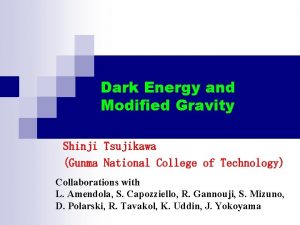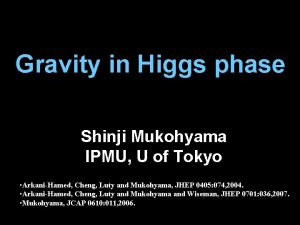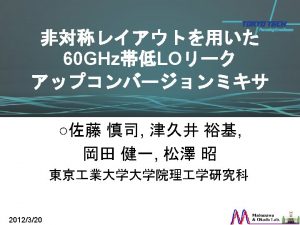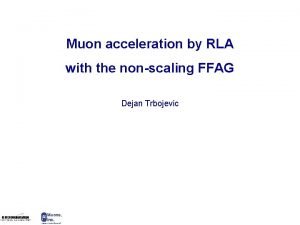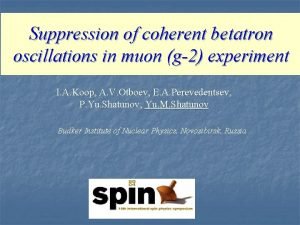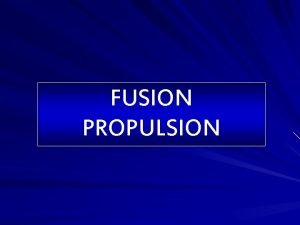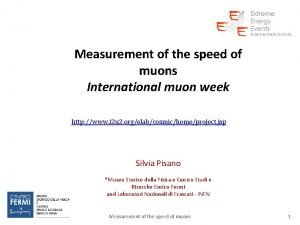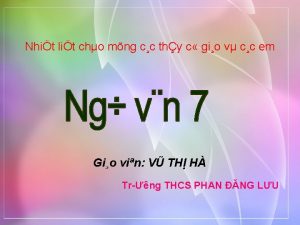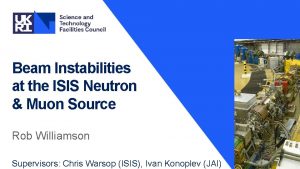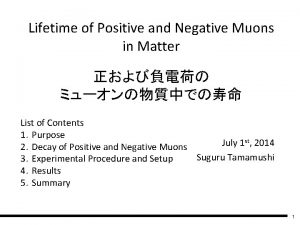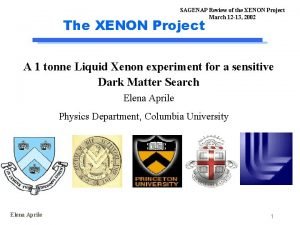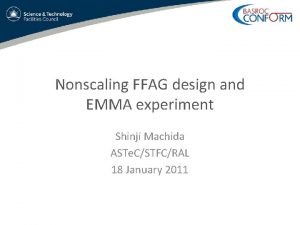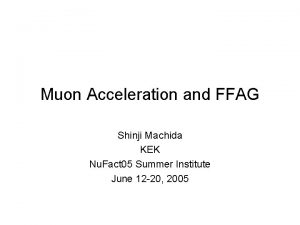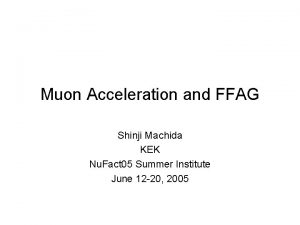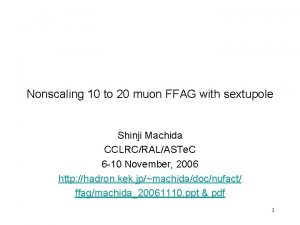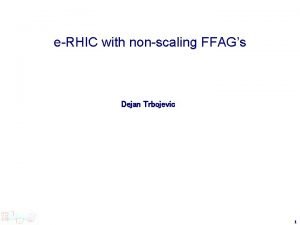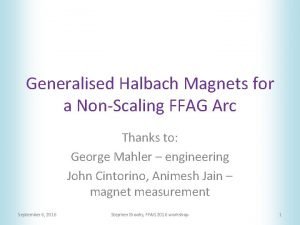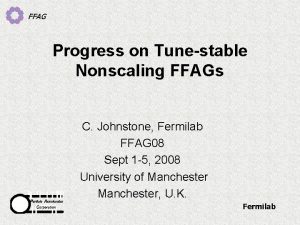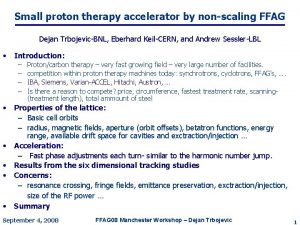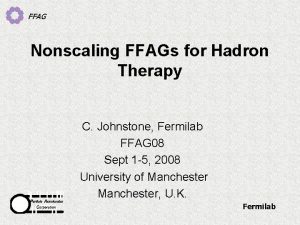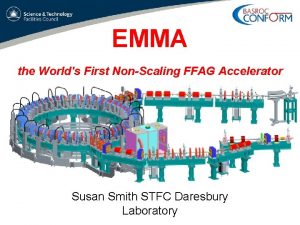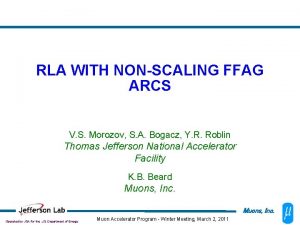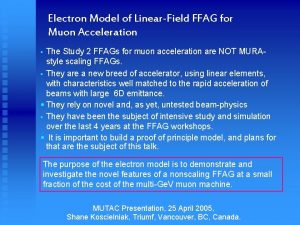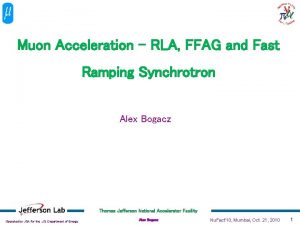Muon acceleration amplitude effects in nonscaling FFAG Shinji



















- Slides: 19

Muon acceleration - amplitude effects in non-scaling FFAG Shinji Machida CCLRC/RAL/ASTe. C 26 April, 2006 http: //hadron. kek. jp/~machida/doc/nufact/ ffag/machida_20060426. ppt & pdf 1

Contents • • Code benchmarking Possible cures of “amplitude problem” Matching between two FFAG rings Next steps 2

Code benchmark (1) • Zgoubi and S(hinji’s)-code had discrepancy (? ) Zgoubi S-code (5 to 10 Ge. V: 30 p mm in transverse, 0. 05 e. Vs in longitudinal. ) • Initial distributions were different. – Zgoubi assumed 6 -D ellipsoid. S-code assumed 2 -D ellipse independently in horizontal, vertical, and longitudinal space. 3

Code benchmark (2) • With the same initial condition: independent in each plane. Zgoubi S-code (10 to 20 Ge. V: 30 p mm in transverse, 0. 05 e. Vs in longitudinal. ) • Large amplitude particles make a problem also on Zgoubi. • Another confirmation of the problem by Keil with MAD. 4

Code benchmark (3) Some particles are not accelerated. No correlation Jl<a, Jh<a, and Jv<a Correlation in T only Jl<a and Jh+Jv<a Correlation in L and T Jl+Jh+Jv<a Correlation between transverse and longitudinal space eliminates large amplitude particles in both planes. (10 to 20 Ge. V: 30 p mm in transverse, 0. 05 e. Vs in longitudinal. ) a is amplitude in normalized phase space. 5

Code benchmark (4) • In real life, there will be some correlation between horizontal and vertical, but probably independent of longitudinal. • The best way is to take particle distribution at the end of linac or RLA. Use it as an initial distribution to FFAG. 6

Possible cures (1) • Longitudinal dynamics is parameterized by Relative energy gain per phase slip. RF frequency relative to revolution freq. dp/p (normalized) Amplitude effects 0 25 36 p mm Phase (1/2 pi) Left figure is slightly different for finite amplitude particle. 7

Possible cures (2) • Cure 1 – Increase V to increase “a”. • Cure 2 – Decrease w to increase “a”. • Cure 3 – Flatten crest by introduction of higher harmonics. 8

Possible cures (RF voltage) e=0 pi, V=1 dp/p=0. 36% e=30 pi, V=1 dp/p=2. 8% e=30 pi, V=1. 4 dp/p=0. 88% Dp/p_rms 5% 0% 1 e=30 pi V/V_nominal 2 9

Possible cures (RF voltage) • 50% increase of RF voltage makes dp/p around 1% up to 50 pi mm. 10

Possible cures (higher harmonics) e=0 pi, h=1 dp/p=0. 36% e=0 pi, h=1+2 dp/p=0. 42% e=30 pi, h=1+2 dp/p=0. 58% e=30 pi, h=1+3 dp/p=0. 77% 11

Possible cures (higher harmonics) • Second harmonics makes dp/p around 1% up to 50 pi mm. • It requires more RF power because second harmonics reduce peak voltage 25%. 12

Possible cures (lower frequency) 274 MHz e=30 pi, V=1 dp/p=2. 8% 44 MHz e=30 pi, V=2 x 44/200 dp/p=1. 4% 88 MHz e=30 pi, V=2 x 88/200 dp/p=1. 2% 2 MHz e=30 pi, V=4 x 2/200 dp/p=3. 7% 13

Possible cures (lower frequency) • Lower frequency helps. • However, it requires relatively higher voltage and time to complete acceleration. 14

Possible cures (summary) • Increase of a few 10% of RF voltage or second harmonics makes dp/p around 1% up to 50 pi mm beam. • That requires additional RF power. • Amplitude effects can be cured when there is only one FFAG. 15

Matching between two FFAG rings (1) • Zero transverse emittance beam has no problem of longitudinal matching. longitudinal phase space 20 Ge. V 3% dp/p_rms 2% 10 Ge. V 1% 5 Ge. V 0% 5 6 10 20 [Ge. V] 16

Matching between two FFAG rings (2) e=30 pi, h=1, V=1 e=30 pi, h=1+2, V=1. 1 • Second harmonics and 10% increase of RF voltage partially cure the problem. • It depends decay ring acceptance if it is allowed. 17

Matching between two FFAG rings (3) • Still many parameters we can play with. – – Injection phase of the second ring (partially done). Optical parameters of the first ring at injection (partially done). Combination of 2 or more cures (partially done). etc. • Need criterion: how much dp/p is tolerable. 18

Next steps • Scaling FFAG with “higher” RF frequency – Does 44 MHz, 88 MHz makes a reasonable bucket in scaling FFAG ? – How high is the k-value supposed to be if the frequency is fixed at 200 MHz ? (Berg) k=1800 (my number), 1100 (mori) vs. 800 (present lattice) • How much dp/p can be allowed in the decay ring? – Need a target value for optimization. – RLA may have as much dp/p as FFAG with amplitude effects: a few percent ? – dp/p of scaling FFAG with either low and high frequency is unknown. 19
 Shinji tsujikawa
Shinji tsujikawa Arkani hamed
Arkani hamed Shinji sato
Shinji sato Radial acceleration
Radial acceleration Linear acceleration vs tangential acceleration
Linear acceleration vs tangential acceleration Centripetal acceleration is
Centripetal acceleration is Tangential acceleration and centripetal acceleration
Tangential acceleration and centripetal acceleration Linear quantity
Linear quantity Muon collider
Muon collider Muon g-2
Muon g-2 Cách tính chu vi hình tam giác
Cách tính chu vi hình tam giác Muôn thiên thần cánh trắng
Muôn thiên thần cánh trắng Muon-catalyzed fusion
Muon-catalyzed fusion đến muôn đời con cảm tạ
đến muôn đời con cảm tạ Speed of muon
Speed of muon Mot que
Mot que Isis neutron and muon source
Isis neutron and muon source Positive muon
Positive muon Toshiyuki kamioka
Toshiyuki kamioka Bận lòng chi nắm bắt
Bận lòng chi nắm bắt
